 During
the Al Adha holiday we took a day to visit the two major cities of Lebanon
south of Beirut, Sidon and Tyre. The banner at the left shows a panoramic
picture of one of Tyre's most famous ruins, a huge Roman necropolis (crypt),
with an arc de triomphe at its entrance.
During
the Al Adha holiday we took a day to visit the two major cities of Lebanon
south of Beirut, Sidon and Tyre. The banner at the left shows a panoramic
picture of one of Tyre's most famous ruins, a huge Roman necropolis (crypt),
with an arc de triomphe at its entrance.
A Little Background.....
Although
the earliest origins of Tyre are unknown, the testimonies of ancient historians
and some archaeological evidence suggest it goes back to the start of the
3rd millennium BC. Originally a mainland settlement with an island city
a short distance offshore, it came of age in the 10th century BC when King
Hiram expanded the mainland and built two ports and a temple to honor Melkart,
the city's god. Its flourishing maritime trade, Mediterranean colonies,
its purple dye and glass industries made Tyre very powerful and wealthy.
But the city's wealth attracted enemies. In the 6th century BC the Tyrians
successfully defied Nebuchadnezzar for 13 years. Alexander The Great laid
siege to it for 7 years, finally overwhelming the island city by constructing
a great causeway from the shore to the island.
In
their day the Romans built a magnificent city at Tyre. The remains of its
Roman streets, arcades and public buildings, including one of the largest
hippodromes of the period, are Tyre's major attractions. Occupied by the
Muslim Arabs in 636, then captured in 1124 by the Crusaders, Tyre was an
important fortified town of the kingdom of Jerusalem. In 1291 the Mamlukes
took the city; during the 400 year Ottoman period (beginning 1516) it remained
a quiet town. Now a sleepy port town, it was incorporated into the nation
of Lebanon at the end of World War I. It is a charming place in which to
while away vacation time.
The
City of Tyre
 What
remains of Tyre, in addition to the archeological treasures described below,
is a fishing town of approximately 250,000, with an old city filled with
the characteristic Middle East bazaars or souks (located on the landfill
connecting the original island to the mainland) and a new city, located
inland. Tyre has a colorful souk (market) well worth exploring. Unfortunately,
it was closed on our visit, due to the religious holiday. Near the market
you'll see a busy fisherman's port, in Phoenician times referred to as
the "Sidonian port" because it faced north towards Sidon. Along the port
with the sea on your right is the city's Christian Quarter, a picturesque
area of narrow streets, traditional architecture, and the Seat of the Maronite
Bishop of Tyre and the Holy Land.
What
remains of Tyre, in addition to the archeological treasures described below,
is a fishing town of approximately 250,000, with an old city filled with
the characteristic Middle East bazaars or souks (located on the landfill
connecting the original island to the mainland) and a new city, located
inland. Tyre has a colorful souk (market) well worth exploring. Unfortunately,
it was closed on our visit, due to the religious holiday. Near the market
you'll see a busy fisherman's port, in Phoenician times referred to as
the "Sidonian port" because it faced north towards Sidon. Along the port
with the sea on your right is the city's Christian Quarter, a picturesque
area of narrow streets, traditional architecture, and the Seat of the Maronite
Bishop of Tyre and the Holy Land.
The
Archeology of Tyre
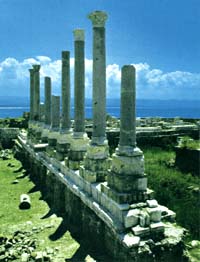 Tyre
is home to many archaeological sites, and in 1979 UNESCO
declared it a World Heritage Site. There are three areas to cover when
visiting the sites. Area One, located on what was the Phoenician
island, is a vast district of civic buildings, colonnades,
Tyre
is home to many archaeological sites, and in 1979 UNESCO
declared it a World Heritage Site. There are three areas to cover when
visiting the sites. Area One, located on what was the Phoenician
island, is a vast district of civic buildings, colonnades, 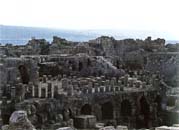 public
baths, mosaic streets and a rectangular arena. These columns (shown to
the left) form a public walkway out to the sea, making it a favorite spot
from which to view Tyre. On our walk out there we ran into two teachers
from ACS and their friends from Northfield Mount Hermon, who turned out
to be friends of colleagues from Durham Academy--small world indeed! To
the south this promontory overlooks the port which once dispatched ships
to Alexandria and Greece. Next to the walkway are the public baths which
formed the other part of the social interaction during Roman times (the
picture on the right)
public
baths, mosaic streets and a rectangular arena. These columns (shown to
the left) form a public walkway out to the sea, making it a favorite spot
from which to view Tyre. On our walk out there we ran into two teachers
from ACS and their friends from Northfield Mount Hermon, who turned out
to be friends of colleagues from Durham Academy--small world indeed! To
the south this promontory overlooks the port which once dispatched ships
to Alexandria and Greece. Next to the walkway are the public baths which
formed the other part of the social interaction during Roman times (the
picture on the right)
 Area
Two is two blocks west. Its major point of interest is a Crusader cathedral.
Only the lowest foundations and a few re-erected granite columns remain
intact but these are nevertheless impressive. The area below has also revealed
a network of Romano-Byzantine roads. Visitors are not allowed inside the
site, but the ruins may be viewed from the road. Although close by, our
hired driver insisted on driving us to the site. Somewhat directionally
challenged (not necessarily a liability for taxi drivers in Lebanon) he
drove us just shy of the border before realizing his error (edged in this
direction by my thinly veiled threats) and forty!five minutes later we
were back at area one. We then walked to the site..Ah, the joys of touring!
Area
Two is two blocks west. Its major point of interest is a Crusader cathedral.
Only the lowest foundations and a few re-erected granite columns remain
intact but these are nevertheless impressive. The area below has also revealed
a network of Romano-Byzantine roads. Visitors are not allowed inside the
site, but the ruins may be viewed from the road. Although close by, our
hired driver insisted on driving us to the site. Somewhat directionally
challenged (not necessarily a liability for taxi drivers in Lebanon) he
drove us just shy of the border before realizing his error (edged in this
direction by my thinly veiled threats) and forty!five minutes later we
were back at area one. We then walked to the site..Ah, the joys of touring!
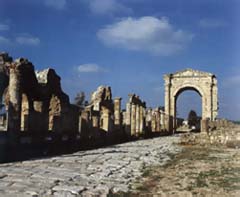 Area
Three is a thirty minute walk away and consists of an extensive
Area
Three is a thirty minute walk away and consists of an extensive 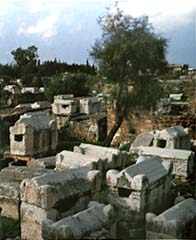 necropolis,
a three-bay monumental arch and one of the largest Roman hippodromes ever
found. The entryway to the complex is from the northwest through a large
arc de triomphe, which nearly dwarfs the surrounding columns (seen on the
left). The Necropolis itself dates from Roman times and, as the picture
to the right reveals, has suffered from exposure, shifting ground, and,
unfortunately, the ravages of stray artillery shells which are reminders
that the south of Lebanon still falls under the shadow of war. The picture
below shows the detailed work found on many of the sarcophagi
necropolis,
a three-bay monumental arch and one of the largest Roman hippodromes ever
found. The entryway to the complex is from the northwest through a large
arc de triomphe, which nearly dwarfs the surrounding columns (seen on the
left). The Necropolis itself dates from Roman times and, as the picture
to the right reveals, has suffered from exposure, shifting ground, and,
unfortunately, the ravages of stray artillery shells which are reminders
that the south of Lebanon still falls under the shadow of war. The picture
below shows the detailed work found on many of the sarcophagi 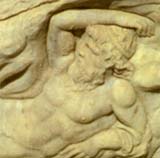
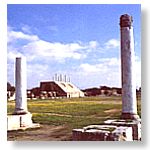 Perhaps
the most impressive feature (at least in terms of scale) is the hippodrome.
Just like the one in the movie Ben Hur, it was a long and narrow
track with dangerously tight turns. Using horse-drawn chariots, few racers
survived more than a few laps around the congested turns. The sport was
popular with the locals as well as the ruling Romans.
Perhaps
the most impressive feature (at least in terms of scale) is the hippodrome.
Just like the one in the movie Ben Hur, it was a long and narrow
track with dangerously tight turns. Using horse-drawn chariots, few racers
survived more than a few laps around the congested turns. The sport was
popular with the locals as well as the ruling Romans.
From Tyre, we journeyed north to Lebanon's third most populous city, the port town of Sidon. . .

Back to Our Home Page
 What
remains of Tyre, in addition to the archeological treasures described below,
is a fishing town of approximately 250,000, with an old city filled with
the characteristic Middle East bazaars or souks (located on the landfill
connecting the original island to the mainland) and a new city, located
inland. Tyre has a colorful souk (market) well worth exploring. Unfortunately,
it was closed on our visit, due to the religious holiday. Near the market
you'll see a busy fisherman's port, in Phoenician times referred to as
the "Sidonian port" because it faced north towards Sidon. Along the port
with the sea on your right is the city's Christian Quarter, a picturesque
area of narrow streets, traditional architecture, and the Seat of the Maronite
Bishop of Tyre and the Holy Land.
What
remains of Tyre, in addition to the archeological treasures described below,
is a fishing town of approximately 250,000, with an old city filled with
the characteristic Middle East bazaars or souks (located on the landfill
connecting the original island to the mainland) and a new city, located
inland. Tyre has a colorful souk (market) well worth exploring. Unfortunately,
it was closed on our visit, due to the religious holiday. Near the market
you'll see a busy fisherman's port, in Phoenician times referred to as
the "Sidonian port" because it faced north towards Sidon. Along the port
with the sea on your right is the city's Christian Quarter, a picturesque
area of narrow streets, traditional architecture, and the Seat of the Maronite
Bishop of Tyre and the Holy Land. During
the Al Adha holiday we took a day to visit the two major cities of Lebanon
south of Beirut, Sidon and Tyre. The banner at the left shows a panoramic
picture of one of Tyre's most famous ruins, a huge Roman necropolis (crypt),
with an arc de triomphe at its entrance.
During
the Al Adha holiday we took a day to visit the two major cities of Lebanon
south of Beirut, Sidon and Tyre. The banner at the left shows a panoramic
picture of one of Tyre's most famous ruins, a huge Roman necropolis (crypt),
with an arc de triomphe at its entrance.
 Tyre
is home to many archaeological sites, and in 1979 UNESCO
declared it a World Heritage Site. There are three areas to cover when
visiting the sites. Area One, located on what was the Phoenician
island, is a vast district of civic buildings, colonnades,
Tyre
is home to many archaeological sites, and in 1979 UNESCO
declared it a World Heritage Site. There are three areas to cover when
visiting the sites. Area One, located on what was the Phoenician
island, is a vast district of civic buildings, colonnades,  public
baths, mosaic streets and a rectangular arena. These columns (shown to
the left) form a public walkway out to the sea, making it a favorite spot
from which to view Tyre. On our walk out there we ran into two teachers
from ACS and their friends from Northfield Mount Hermon, who turned out
to be friends of colleagues from Durham Academy--small world indeed! To
the south this promontory overlooks the port which once dispatched ships
to Alexandria and Greece. Next to the walkway are the public baths which
formed the other part of the social interaction during Roman times (the
picture on the right)
public
baths, mosaic streets and a rectangular arena. These columns (shown to
the left) form a public walkway out to the sea, making it a favorite spot
from which to view Tyre. On our walk out there we ran into two teachers
from ACS and their friends from Northfield Mount Hermon, who turned out
to be friends of colleagues from Durham Academy--small world indeed! To
the south this promontory overlooks the port which once dispatched ships
to Alexandria and Greece. Next to the walkway are the public baths which
formed the other part of the social interaction during Roman times (the
picture on the right) Area
Two is two blocks west. Its major point of interest is a Crusader cathedral.
Only the lowest foundations and a few re-erected granite columns remain
intact but these are nevertheless impressive. The area below has also revealed
a network of Romano-Byzantine roads. Visitors are not allowed inside the
site, but the ruins may be viewed from the road. Although close by, our
hired driver insisted on driving us to the site. Somewhat directionally
challenged (not necessarily a liability for taxi drivers in Lebanon) he
drove us just shy of the border before realizing his error (edged in this
direction by my thinly veiled threats) and forty!five minutes later we
were back at area one. We then walked to the site..Ah, the joys of touring!
Area
Two is two blocks west. Its major point of interest is a Crusader cathedral.
Only the lowest foundations and a few re-erected granite columns remain
intact but these are nevertheless impressive. The area below has also revealed
a network of Romano-Byzantine roads. Visitors are not allowed inside the
site, but the ruins may be viewed from the road. Although close by, our
hired driver insisted on driving us to the site. Somewhat directionally
challenged (not necessarily a liability for taxi drivers in Lebanon) he
drove us just shy of the border before realizing his error (edged in this
direction by my thinly veiled threats) and forty!five minutes later we
were back at area one. We then walked to the site..Ah, the joys of touring!
 Area
Three is a thirty minute walk away and consists of an extensive
Area
Three is a thirty minute walk away and consists of an extensive  necropolis,
a three-bay monumental arch and one of the largest Roman hippodromes ever
found. The entryway to the complex is from the northwest through a large
arc de triomphe, which nearly dwarfs the surrounding columns (seen on the
left). The Necropolis itself dates from Roman times and, as the picture
to the right reveals, has suffered from exposure, shifting ground, and,
unfortunately, the ravages of stray artillery shells which are reminders
that the south of Lebanon still falls under the shadow of war. The picture
below shows the detailed work found on many of the sarcophagi
necropolis,
a three-bay monumental arch and one of the largest Roman hippodromes ever
found. The entryway to the complex is from the northwest through a large
arc de triomphe, which nearly dwarfs the surrounding columns (seen on the
left). The Necropolis itself dates from Roman times and, as the picture
to the right reveals, has suffered from exposure, shifting ground, and,
unfortunately, the ravages of stray artillery shells which are reminders
that the south of Lebanon still falls under the shadow of war. The picture
below shows the detailed work found on many of the sarcophagi 
 Perhaps
the most impressive feature (at least in terms of scale) is the hippodrome.
Just like the one in the movie Ben Hur, it was a long and narrow
track with dangerously tight turns. Using horse-drawn chariots, few racers
survived more than a few laps around the congested turns. The sport was
popular with the locals as well as the ruling Romans.
Perhaps
the most impressive feature (at least in terms of scale) is the hippodrome.
Just like the one in the movie Ben Hur, it was a long and narrow
track with dangerously tight turns. Using horse-drawn chariots, few racers
survived more than a few laps around the congested turns. The sport was
popular with the locals as well as the ruling Romans.